In his role as Head of Digital Channels at NatWest, Chris Wilkinson is focused squarely on the intersection of technology and the customer, specifically the interplay between product, service and engagement across apps, online banking and digital customer messaging. Chris has over 15 years of experience in financial services, including roles at Metro Bank and Lloyds Banking Group, encompassing strategy, customer experience transformation and digital innovation.

Paul Riseborough: Chris, great to sit down with you. It strikes me that we are talking today at a really interesting moment. We’re seeing lightspeed changes in the potential of new technologies like AI of course, but we also seem to be at the ‘end of the beginning’ of banks becoming truly digital and data-led organisations. They’ve all done the basics, mostly pretty well. The stage therefore feels set for us to enter a more interesting period, one where organisations try to reimagine the customer experience, rather than just providing digital alternatives to what were previously face to face interactions.
Chris Wilkinson: We are genuinely at an inflection point. We're leaving the era of banking digitization, by which I mean digitizing the activities and processes that have always been part of what banks have done. That digitization has been a sizable achievement at an industry level in terms of making life for customers much more simple and convenient. It has been good for them, and as an industry has also transformed our cost base.
The thing with digitization, though, is there is a natural plateau to it – and that is where we are now. Most customers, though of course not all, can now largely do everything they need online, a few edge cases aside where human interactions still make a real difference.
At the same time, as an industry we have to ask ourselves whether we have fundamentally given customers new powers? Have we created new forms of relevance, new forms of usefulness? That is what the future will be about – moving from just being a service platform to being an engagement platform.
Banks have spent the last 20 years migrating customers into lower cost channels, and the incremental cost of interaction today is tending towards zero – so the next step is to look at how we can maximize the number of meaningful interactions and create new forms of relevance and usefulness for our customers. That’s a big mindset shift. Financial wellbeing is an obvious area of focus for this.
Paul Riseborough: Perhaps a key question is how do banks better understand the motivations of their customers? Preferences are changing, and customers have been transitioning their banking to digital in a big way for many years now, and there are now clearly new avenues to explore from a service perspective. But how do you get underneath the expectations, the motivations of your customers, because ultimately you want to create a deeper, more meaningful relationship with them.
Chris Wilkinson: The question for our industry is whether banking is really at the heart of consumers’ financial worlds at the moment. For me there's a breakthrough that has yet to happen, and as an industry getting that right will be our main driver of value, retention, and earnings resilience over the next decade.
As an industry we have sometimes taken a bank-centric approach to being customer focused, and plenty of false assumptions have been made – not least that if you had the current account, then you owned the relationship and were accordingly the hub of that customer’s financial world. But today we know that an increasing number of our digitally active customers are also digitally active with other banks, and have other banking apps on their phone – and customers often like that separation.
An ever greater focus for us is the ability to experiment at scale. We constantly need to strike the right balance between pushing forward with our ambition and innovating, and not disorientating our less digitally confident customers who might like things just how they are. Having the capability to pilot new ideas with select customer groups will help us land bold change successfully.
Then there's operational capability: how do we help our colleagues support customers who are part of the initiative. There's also the customer narrative to consider. We often only tell customers about a new capability once we've launched it. So how we more proactively engage our customers around future innovation is something else we will be changing.
It’s about earning the right to do cool, cutting-edge things while not totally freaking out your customers.


Paul Riseborough: So what needs to be in place for that sort of experimentation at scale? In terms of not just the technology foundations but also skills, training, talent and culture? And even when you can experiment at scale, you also have to design for exception cases. How do you avoid drifting towards a lowest common denominator approach when designing new products and services?
Chris Wilkinson: That’s such an important point. As a Big Four bank we do have plenty of customers that are excited by such offerings – but many other customers equally wouldn’t thank us for changing what they’ve already taken years getting used to. We have 10 million customers using our app. As a group they are incredibly diverse, whether from a product perspective, a demographics perspective, and an attitudinal perspective.
That’s why a big focus over the next 12 to 24 months is to approach personalization in new ways. Increasingly, our app will look and behave differently for different customers – based on who you are, the role we’re currently playing in your life. Personalization is sometimes equated with being a just a data problem, or even distilled more narrowly into just personalized messaging within an app…
Paul Riseborough: When in reality it could be about them making choices about how they configure their own banking experience...
Chris Wilkinson: Exactly that. When banks talk about personalization and our customers talk about personalization, we’re often talking about different things. For them, a service like Spotify is the benchmark.
Paul Riseborough: Yes, there is a particular intimacy of design at play there. It feels curated to what I like, but also retains the capacity to surprise and introduce me to new things.
Chris Wilkinson: Personalization is a feeling that we create. It isn't just about smart use of data science, which is not to say that there isn't a role for data science to play. A good example of this is creating configurable experiences that customers make their own. Take smart phones. From a form factor perspective, they're all essentially pretty much identical – yet they're each unique because we've all installed different permutations of apps, customised our home screen backgrounds, and so on. That personalization hasn't been done by GenAI or data science – it turns out that customers are happy to do the hard work of personalization themselves. That’s why we’re going to be experimenting with a widget-based experience, with different defaults to accommodate different segments, different cohorts, and different kinds of product groups.

Paul Riseborough: So while to some degree there's a centrally driven map or framework there, what we're really talking about is customers being able to curate their own banking experience – the specific services, products, and information flows that they want to see.
Chris Wilkinson: Spot on. And alongside creating this flexibility, we’re working hard to be pre-emptive. As customers, we are all creatures of habit. We all have certain habits and routines that we repeat over and over again. So let's not force customers to start from scratch every time they're engaging in a routine tasks or activities. That is another part of how we’re thinking about personalization.
Paul Riseborough: I'm really struck by your point around inviting engagement. In past years that was seen internally as just more cost coming your way, but now demand can be managed in a really efficient way – and actually drive a return for the bank if done well… I’d like to circle back to the idea of curation, how do you see that concept evolving?
Chris Wilkinson: When we think about the next horizon, banking apps – and apps generally – have existed within an interaction paradigm where we proactively use one app at a time. That app monopolises our experience while we're using it – we even use the language of ‘going into’ an app and then ‘leaving’ the app.
The future is going to look a lot more contextual and curated. Customers will spend less time navigating ‘boxed’ experiences and instead rely much more on the ‘operating systems’ of their lives to curate the right kind of experience. Fragments combined at the right times in the right way – for instance, banking services that surface in a much more vivid way when you are at the supermarket checkout or in an e-commerce interaction than is the case today.
We need to be thinking much more about how we how we build for reuse and design at a fragment level – enabling banking experiences to be surfaced in other environments. Across the industry we have been investing in filling capability gaps and creating strategic evergreen platforms – and we’ve done that well. We’ve eliminated the vast majority of ‘end of life’ technology, certainly from a channels perspective. The challenge – the exciting opportunity – now is how do we stitch these elements together in new and creative ways.
Paul Riseborough: The priority being essentially to overcome and eliminate points of friction and frustration in the user experience.
Chris Wilkinson: Exactly that. Take for example how we are thinking about engagement in the mobile space. Crudely put, engagement is the intersection between having relevant and valuable conversations with our customers and creating the right spaces within that experience. When we think about that, we look at the interaction patterns that make social media so compelling – how do we use that as a force for good? But it is also about having the right content assets and the right kind of content management sitting beneath that.


Paul Riseborough: It strikes me as a repositioning of interest – that banking and your financial life shouldn’t just be another utility.
Chris Wilkinson: Yes. How do we create an experience that customers want to check in on. That requires delivering insights and value in a way that is engaging.
Paul Riseborough: “You’ve talked about personalisation, engagement, new forms of design and the technology foundations needed to enable experimentation. From a personal perspective, what trends do you see as defining the next five years when you think about digital customer experience design? What in your view is going to really capture the imagination of customers?"
Chris Wilkinson: Within banking we still have scope to enhance the capability we offer customers to describe their financial world in a way that can be visualized back to them so that they better understand their financial interdependencies and the implications of their decisions. How do we simulate that so that customers intuit or feel that they are seeing or experiencing something that really meshes with the mental model they hold in their heads of their own financial worlds and biases.
Certainly, individuals are diverse in how they think about these things, but I do feel a breakthrough is just around the corner, though it will not be down to any a single technology. It’s going to be predicated on the smarter connection of existing technologies, GenAI potentially being one – and it's also going to be about borrowing from social media and other industries in a way that we haven't had the head space to do whilst we’ve all been busy cracking digitization.









